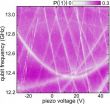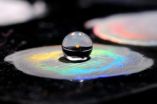(Press-News.org) DURHAM, N.H. – Astrophysicists from the University of New Hampshire's Space Science Center (SSC) have created the first online system for predicting and forecasting the radiation environment in near-Earth, lunar, and Martian space environments. The near real-time tool will provide critical information as preparations are made for potential future manned missions to the moon and Mars.
"If we send human beings back to the moon, and especially if we're able to go to Mars, it will be critical to have a system like this in place to protect astronauts from radiation hazards," says associate professor of physics Nathan Schwadron of the UNH Institute for the Study of Earth, Oceans, and Space (EOS), which houses the SSC.
Schwadron is the lead developer of the new web-based tool known as PREDICCS, which for the first time integrates numerical models of space radiation, a host of real-time measurements being made by satellites currently in space, and "propagation codes" that can accurately project radiation levels out as far as Mars. The tool was made possible through NASA's Living With A Star (LWS) Targeted Research and Technology program.
The website provides updates of the radiation environment on an hourly basis and archives the data weekly, monthly, and yearly. This historical record provides a clear picture of when a safe radiation dose limit is reached for skin or blood-forming organs, for example.
Says Schwadron, "What we really need to know is how hazardous this cycle of radiation is. How often do we see large events that have significant risk associated with them? Those questions can only be answered if you're continually building up the database of events and the risk associated with them."
He notes further that the space science community has traditionally viewed radiation hazards in space as a "showstopper" and that until PREDICCS there has never been an extremely accurate, nearly real-time means of challenging that.
"There hasn't been enough work done to ask, 'Is it really a showstopper and, if so, why, and what are the problems we need to solve so that it isn't a showstopper?'"
That work has now been done, and the proof is in PREDICCS.
Among other satellite measurements used by PREDICCS are solar energetic particle data from the Cosmic Ray Telescope for the Effects of Radiation
(CRaTER) instrument on NASA's Lunar Reconnaissance Orbiter. CRaTER, whose principal investigator is Harlan Spence, director of EOS and a co-developer of PREDICCS, has made the most accurate and comprehensive measurements of radiation at the moon since the dawn of the space age.
During several recent large solar events in which the sun, waking from an unusually long quiet period, sent billions of tons of high-energy particles rippling through space, the radiation levels measured by CRaTER as it orbited the moon were matched almost perfectly by PREDICCS.
"For the whopping solar events of January 23 and March 27 of this year, our predictions seem to be within 20 to 30 percent of what was observed, which is incredible. These types of highly accurate comparisons have never been made before," Schwadron says.
CRaTER, which gauges radiation doses using a high-tech material called "tissue-equivalent plastic" that mimics human muscle, has thus not only provided the validation that PREDICCS models are accurate, but has done so in the context of how the radiation data would impact human beings on the moon or on a mission to Mars.
"We needed to accurately assess what the biological impacts are to make the best quantitative comparisons between models and observations," says Schwadron, "and having a system like this in place now is sort of like flying a trial balloon in preparation for a return to the moon and a trip to Mars."
To make its radiation assessments, PREDICCS integrates two radiation environment models, including the Earth-Moon-Mars Radiation Environment Module (EMMREM) developed at UNH.
"Complex applications like EMMREM are able to leverage observations from all relevant space missions," notes NASA's Madhulika Guhathakurta, LWS program scientist.
A blog has been developed for PREDICCS that allows people to understand how the tool works and how to interpret the various graphs of radiation dosage.
Note's Schwadron, "For the first time people are able to see the affects of space radiation playing out in near real-time, and this opens a new window to an otherwise invisible world."
###
To view the PREDICCS website, visit http://prediccs.sr.unh.edu/.
The goal of the LWS is to develop the scientific understanding needed for the U.S. to effectively address those aspects of the connected sun-Earth system that may affect life and society. The program's Targeted Research and Technology objectives can be achieved by data analysis, theory and modeling, and the development of tools and methods.
The University of New Hampshire, founded in 1866, is a world-class public research university with the feel of a New England liberal arts college. A land, sea, and space-grant university, UNH is the state's flagship public institution, enrolling 12,200 undergraduate and 2,300 graduate students.
Photograph to download: http://www.eos.unh.edu/newsimage/radiationhazard_lg.jpg
Caption: In this artist's rendition, particle radiation from a solar flare speeds away from the sun along curved magnetic field lines (blue lines) and arrives before the coronal mass ejection (orange mass from the sun) and its driven shock. PREDICCS provides a real-time window on space weather events like this, which allows situational awareness of the hazards posed by the space radiation environment. Image courtesy of Nathan Schwadron, UNH-EOS.
UNH scientists provide window on space radiation hazards
2012-10-15
ELSE PRESS RELEASES FROM THIS DATE:
Science: Quantum oscillator responds to pressure
2012-10-15
In the far future, superconducting quantum bits might serve as components of high-performance computers. Today already do they help better understand the structure of solids, as is reported by researchers of Karlsruhe Institute of Technology in the Science magazine. By means of Josephson junctions, they measured the oscillations of individual atoms "tunneling" between two positions. This means that the atoms oscillated quantum mechanically. Deformation of the specimen even changed the frequency (DOI: 10.1126/science.1226487).
"We are now able to directly control the frequencies ...
Gene suppression can reduce cold-induced sweetening in potatoes
2012-10-15
This press release is available in Spanish.Preventing activity of a key enzyme in potatoes could help boost potato quality by putting an end to cold-induced sweetening, according to U.S. Department of Agriculture (USDA) scientists.
Cold-induced sweetening, which occurs when potatoes are put in long-term cold storage, causes flavor changes and unwanted dark colors in fried and roasted potatoes. But long-term cold storage is necessary to maintain an adequate supply of potatoes throughout the year.
Agricultural Research Service (ARS) scientists found that during cold ...
Fearful flyers willing to pay more and alter flight plans, according to travel study
2012-10-15
BEER-SHEVA, ISRAEL, October 15, 2012 -- Fearful flyers seek flight attributes that may be primarily reassuring, such as schedule, aircraft size and carrier origin, but have little effect on the low, actual risk according to a study published in the Journal of Travel Research.
People with fear of flying (FOF) are willing to pay more for a number of choices that help them alleviate their fear, according to the study by researchers at Ben-Gurion University of the Negev (BGU), The Hebrew University of Jerusalem and Technion Israel Institute of Technology.
According to ...
Study says VeriStrat predicts response but not survival benefit from erlotinib
2012-10-15
DENVER – A study, published in the November 2012 issue of the International Association for the Study of Lung Cancer's (IASLC) Journal of Thoracic Oncology, showed the plasma test VeriStrat can predict response but not survival benefit from erlotinib. The study was conducted on a subset of patients enrolled in the NCIC Clinical Trials Group, BR.21 phase III trial of erlotinib versus placebo in previously treated advanced non-small cell lung cancer patients.
VeriStrat is a commercially available serum-based or plasma-based test using matrix-assisted laser desorption ionization ...
Study shows revisions in MPM staging system might be needed in future
2012-10-15
DENVER – The International Mesothelioma Interest Group (IMIG) staging system has been widely used, however, widespread concerns exist about the validity of the current malignant pleural mesothelioma (MPM) staging system. Concerns include that the system is derived from analysis of small, retrospective surgical series; it can be difficult to apply to clinical staging; and uses descriptors for lymph node involvement, which may not be relevant to MPM. Therefore, in collaboration with IMIG, the International Association for the Study of Lung Cancer (IASLC) has decided to update ...
Study shows fit elderly patients should be considered for therapy
2012-10-15
DENVER – Until there are more validated biomarkers to direct treatment decisions, many physicians use patient age to decide what therapy to give their patients. Literature data report that older patients often go undertreated because of concerns for limited tolerance to toxic therapies. A study, published in the November 2012 issue of the International Association for the Study of Lung Cancer's (IASLC) Journal of Thoracic Oncology, says that fit elderly non-small cell lung cancer (NSCLC) patients should be considered for salvage targeted therapy.
The study looked at ...
Native plant fares well in pilot green roof research study
2012-10-15
As the implementation of green roofs increase, a University of Cincinnati pilot study examined which plants best thrive on the Southwest Ohio region's roofs during the dry, hot conditions of summer.
That research, by UC biology student Jill Bader and Ishi Buffam, assistant professor of biology, identified a North American (and Ohio) native plant – nodding wild onion (Allium cernuum) and a European sedum (Sedum acre, also known as goldmoss sedum) as suited to survive and thrive on the region's green roofs.
Their research will be presented in a paper titled "Ohio Native ...
New research reveals more about how the brain processes facial expressions and emotions
2012-10-15
NEW ORLEANS — Research released today helps reveal how human and primate brains process and interpret facial expressions, and the role of facial mimicry in everything from deciphering an unclear smile to establishing relationships of power and status. The findings were presented at Neuroscience 2012, the annual meeting of the Society for Neuroscience and the world’s largest source of emerging news about brain science and health.
Facial mimicry — a social behavior in which the observer automatically activates the same facial muscles as the person she is imitating — plays ...
Bacterial protein in house dust spurs asthma according to NIH study
2012-10-15
A bacterial protein in common house dust may worsen allergic responses to indoor allergens, according to research conducted by the National Institutes of Health and Duke University. The finding is the first to document the presence of the protein flagellin in house dust, bolstering the link between allergic asthma and the environment.
Scientists from the NIH's National Institute of Environmental Health Sciences (NIEHS) and Duke University Medical Center published their findings in people and mice online Oct. 14 in the journal Nature Medicine.
"Most people with asthma ...
Penn researchers find new way to mimic the color and texture of butterfly wings
2012-10-15
PHILADELPHIA — The colors of a butterfly's wings are unusually bright and beautiful and are the result of an unusual trait; the way they reflect light is fundamentally different from how color works most of the time.
A team of researchers at the University of Pennsylvania has found a way to generate this kind of "structural color" that has the added benefit of another trait of butterfly wings: super-hydrophobicity, or the ability to strongly repel water.
The research was led by Shu Yang, associate professor in the Department of Materials Science and Engineering at Penn's ...


